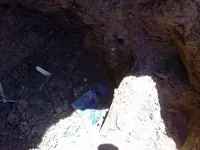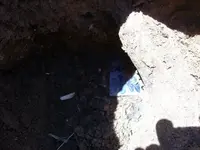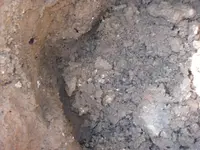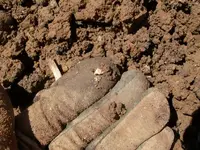BuckleBoy
Platinum Member
- Joined
- Jun 12, 2006
- Messages
- 18,132
- Reaction score
- 9,701
- Golden Thread
- 4
- Location
- Moonlight and Magnolias
- 🥇 Banner finds
- 4
- 🏆 Honorable Mentions:
- 2
- Detector(s) used
- Fisher F75, Whites DualField PI, Fisher 1266-X and Tesoro Silver uMax
- Primary Interest:
- All Treasure Hunting
- #1
Thread Owner
Hello All,
On Saturday I dug down for an iron signal in a plowed (corn stubble) field and found a layer of flat rocks. I removed a few of the rocks, and underneath there was ash mixed in with the soil, plus iron nails and scrap iron pieces, pottery, and glass. I kept a nice piece of stoneware from the hole (gray and blue stenciled).
I also saw something down there (at this point, I was 2 feet down--below plow depth) that I Never see in a plowed field: Lime. At least I think it is lime. It was small bits of chalky material mixed in with the dirt.
When I got to the bottom of the hole, there was clay, which I was unable to dig past.
We will likely be able to get permission to dig deeper in the field from the owners of the property--but my question is this: Should we dig it?
Were privies in rural areas capped in clay in some areas? And how thick was the cap usually? I didn't dig far enough out to find out if it was lined with either stone, wood, or brick.
I've heard a lot of folks say that rural privies aren't worth finding... Is this because there is usually very little in them in the way of glass, or is this because of the difficulty of locating them, or both?
Here are some photos of the layers I was into. The photo of my glove shows the chalky substance I found mixed into the soil all over the place about 2 feet down.
I appreciate your input--and thank you in advance,
-Buckleboy
On Saturday I dug down for an iron signal in a plowed (corn stubble) field and found a layer of flat rocks. I removed a few of the rocks, and underneath there was ash mixed in with the soil, plus iron nails and scrap iron pieces, pottery, and glass. I kept a nice piece of stoneware from the hole (gray and blue stenciled).
I also saw something down there (at this point, I was 2 feet down--below plow depth) that I Never see in a plowed field: Lime. At least I think it is lime. It was small bits of chalky material mixed in with the dirt.
When I got to the bottom of the hole, there was clay, which I was unable to dig past.
We will likely be able to get permission to dig deeper in the field from the owners of the property--but my question is this: Should we dig it?
Were privies in rural areas capped in clay in some areas? And how thick was the cap usually? I didn't dig far enough out to find out if it was lined with either stone, wood, or brick.
I've heard a lot of folks say that rural privies aren't worth finding... Is this because there is usually very little in them in the way of glass, or is this because of the difficulty of locating them, or both?
Here are some photos of the layers I was into. The photo of my glove shows the chalky substance I found mixed into the soil all over the place about 2 feet down.
I appreciate your input--and thank you in advance,
-Buckleboy









